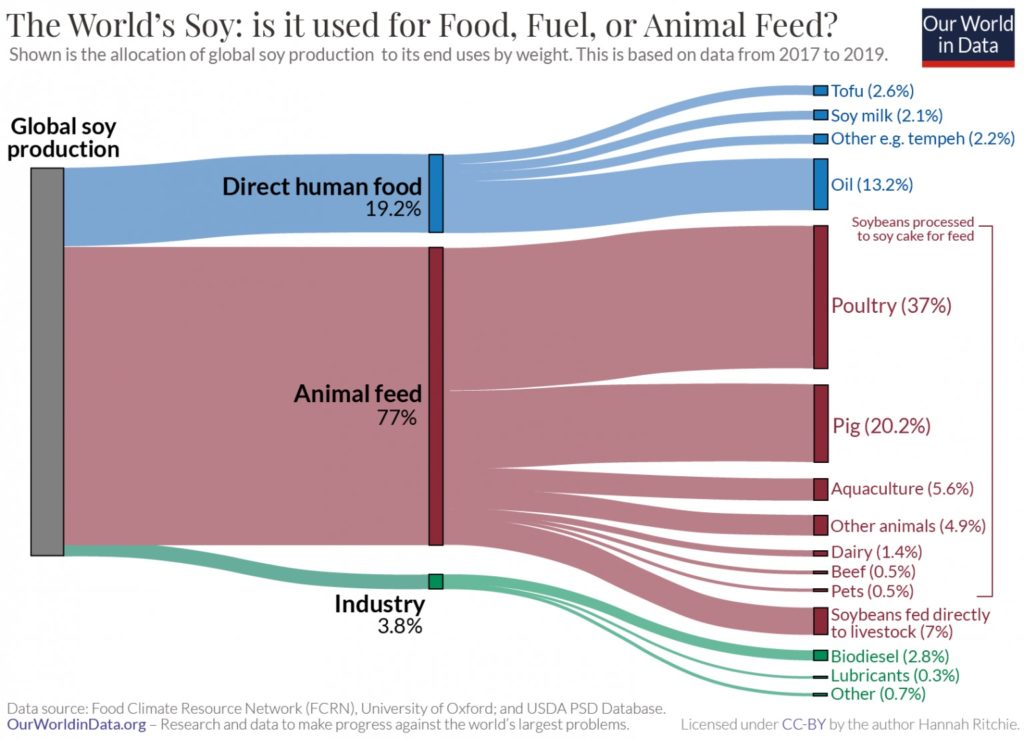The common argument that soybean products are ‘unsustainable’ is a misconception because the majority of soy is used for livestock feed. However, commercial soy farming has undoubtedly taken a toll on the planet’s soils and biodiverse regions. Intergovernmental agreements such as Soy Moratoriums, or providing increased funding for alternative animal feed research are key steps that can be taken to curb soy’s significant environmental footprint.
—
Plant–based alternative proteins have experienced exponential growth over the last few years. The global plant-based protein market is projected to grow from US$10.3 billion in 2020 to 15.6 billion by 2026. Many climate scientists and researchers, including a study by the University of Oxford, state that switching to a more plant–based diet is the best way to avoid the worst impacts of climate change.
A key ingredient found in most plant–based proteins is soy, and it is found in brands such as Linda McCartney’s Meatless Farm and Omni Pork. Soy, also known as soya, is a type of legume native to East Asia. Soybeans are the mature seeds of the soybean plant. Once the seeds mature, they are harvested, bagged and taken to either storage or industrial facilities for processing. Known for its high protein content, soybean products have been a popular source of protein in Asia for centuries and is often consumed in the form of tofu, tempeh or soy milk.
Similarly, the benefits of soy have also made it a popular option for livestock feed. The growth of commercial farms and demand for meat in the 20th century led directly to the explosive growth of soy in the mid 20th century, with the global production of soy today 13 times higher than it was in the 1960s.
However, alongside the commercialisation of soybean products are studies that soy farming is linked to deforestation, loss of biodiversity and other environmentally damaging factors. This finding is used by opponents of plant–based protein, arguing that the use of soy in these products makes them unsustainable, and does not play a part in reducing carbon emissions as claimed by many experts and plant–based brands.
So How Sustainable Are Soybean Products?
The argument that soybean products is unsustainable omits a critical statistic that more than 77% of global soy produced is used to feed livestock. A further 16% is used for biofuels, vegetable oils or other industrial purposes. Soy used directly in products for human consumption such as tofu, tempeh and milk only makes up 7% of global soy usage.
Although the growth of the plant–based protein sector means soy used for human consumption will likely increase, research shows that from an emissions perspective, consuming 1kg of tofu still produces less emissions compared to consuming 1 kg of meat. Matt Turner, a spokesperson from The Vegan Society points out the inefficiency of consuming meat for calories, “Bear in mind that for every 100 calories fed to animals, we receive back only 12 calories by consuming their flesh and milk.”
However, the claim that soy cultivation adversely affects the environment still holds true. Below are the primary ways in which soy farming is adversely damaging the environment.

Deforestation
The world’s two largest producers of soybean products are the US and Brazil. Since soy is a product that only offers one yield per life cycle, fulfilling increased soy demand means planting more soy, thus more land use. The total area of land used to cultivate soy takes up the combined area of the Netherlands, Belgium, France and Germany, making it the second largest driver of deforestation after cattle rearing.
In 2006, an agreement, known as the ‘Amazon Soy Moratorium’, was made between the Brazilian Government, the soy industry, and civil society organisations. The moratorium banned traders from purchasing soybeans from Amazon’s deforested land and also provided that soy production in the Amazon can only occur on existing converted agricultural land. The moratorium successfully reduced the conversion of Amazon’s forest for soy production.
At the same time, deforestation for soy farming remains prevalent in unregulated areas. In South America’s Cerrado Region, only 20% of land needs to be set aside for conservation, leaving the remaining 80% available to be legally deforested for soy farming.
Increased Carbon Emissions
Soy’s contribution to carbon emissions can be traced to multiple activities, including deforestation, industrial processing and transportation.
The conversion of natural landscapes to cultivate soy, also called ‘land use change’, is a major reason for increased carbon emissions in the world’s largest soy producing countries. For example, Bolivia’s greenhouse gas (GHG) emissions are one of the highest in the world per capita equal, despite being one of the least economically developed countries in South America. 80% of Bolivia’s GHG emissions originate from deforestation.This is because clearing forests for soy cultivation releases CO2 and other GHG into the atmosphere.
In addition to carbon emissions caused by deforestation, other parts of the soy life cycle also emit GHG. The use of industrial processing facilities and vehicle fleets to distribute soy globally all contribute to soy’s carbon footprint.
You might also like: Adopting a Plant-Based Diet Would Reduce Agricultural Land Use by 3/4
Negative Impacts on Soil and Water
Soy cultivation is often highly mechanised and requires intensive irrigation. Soy is also a crop that requires significant amounts of water; it is estimated that nearly 300 litres of water is required to produce 1 litre of soy milk.
The combined effect of such farming methods and natural resource consumption has had damaging effects on topsoil. This includes disrupting the soil’s natural ability to absorb CO2 from the atmosphere, its functioning as an ecosystem, and its ability to reabsorb nutrients and water. Brazil loses an estimated 55 million tonnes of topsoil to soy cultivation every year.
As with many commercialised crops, the use of pesticides and fertilisers during soy farming also contaminates rivers, lakes and estuaries, impacting wildlife and posing health risks to rural communities who consume the water.
Biodiversity Loss
Between 2001 to 2010, approximately four million hectares of forest were destroyed each year in South America, primarily for soy and beef production. Although deforestation in these regions are not solely for soy plantations, soy is undoubtedly one of the key reasons for deforestation.
The Cerrado region in South America is one of the most biodiverse regions in the world and is home to 5% of the world’s animal and plant species, including 20 endangered and 12 critically endangered animal species. As of 2018, half of the Cerrado’s savanna and forest has been converted to agricultural land.
This has the direct impact of displacing wildlife and destroying or polluting their food and habitats. Indirectly, damaging healthy soils has made the area more susceptible to forest fires, further threatening biodiversity.
4 Ways to Reduce the Environmental Footprint of Soy?
Although soy will likely remain a major agricultural commodity, there are actions which the agricultural industry, governments and consumers can take to curb the adverse effects of soy farming.
1. Using Alternative Feed To Feed Livestock
Substituting soy with alternative feed for livestock can significantly reduce soy demand. In 2013, the FAO encouraged increased usage of insects as animal feed as it is a more sustainable option compared to soy.
At the same time, substituting soy with other feed may face resistance in the livestock industry, as soy optimises the growth and fat composition of animals. A study comparing the use of soy and the use of other legumes (beans, peas, rape seed) as feed found that since other legumes are less palatable for pigs, it will likely result in slower growth performance and leaner meat. This implies farmers cannot charge higher prices for meat. Increased funding in this area may be needed to develop alternatives that are more sustainable and not detrimental to livestock growth.
2. Importing Only Sustainably Produced Soy
Governments can choose to import only soy brands that are produced sustainably. International organisations such as the Round Table on Responsible Soy (RTRS) or ProTerra Foundation offer soy that is sustainably sourced and farmed.
3. Purchasing Only Organic Soy Products
Consumers can mitigate soy’s environmental impact by purchasing from organic soy brands such as Tofoo, Tofurei and Taifun. Since organic products avoid fertilisers and pesticides, this reduces harm to wildlife and surrounding rural communities.
4. Diversifying Plant Based Diets By Consuming Non Soy-products
Consumers can also opt for other types of legumes such as lentils, fava beans and chickpeas, which also have a very high protein content. Choosing non-soy plant-based products such as Seitan (made of wheat gluten) or Beyond Meat (made of pea and rice protein ) will also lessen the global demand for soy.




















